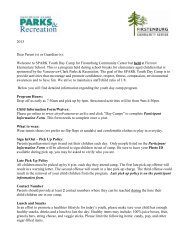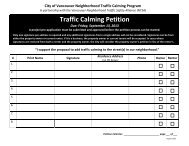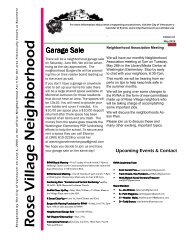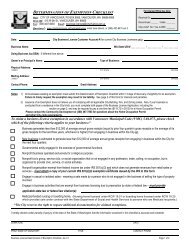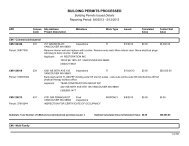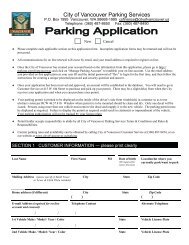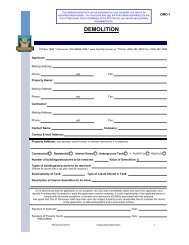Vancouver Comprehensive Plan 2011-2030 - City of Vancouver
Vancouver Comprehensive Plan 2011-2030 - City of Vancouver
Vancouver Comprehensive Plan 2011-2030 - City of Vancouver
- No tags were found...
You also want an ePaper? Increase the reach of your titles
YUMPU automatically turns print PDFs into web optimized ePapers that Google loves.
<strong>Vancouver</strong>’s population,households, and housing in <strong>2011</strong>Population<strong>Vancouver</strong> is home to 162,300 persons as <strong>of</strong><strong>2011</strong>. The city continues to grow, althoughmore slowly in recent years because <strong>of</strong> theeconomic recession and relative scarcity <strong>of</strong>land as the city fills out within its borders. Futuregrowth is anticipated through the development <strong>of</strong>remaining vacant land, redevelopment <strong>of</strong> built orpartially built areas, and annexations in the unincorporated<strong>Vancouver</strong> Urban Growth Area (VUGA).HousingTypes <strong>of</strong> housing. Because people need differenttypes <strong>of</strong> housing at different stages <strong>of</strong> their lives,it is important to provide a variety <strong>of</strong> types <strong>of</strong> housing—apartments for young people just startingout on their own, single-family homes for familieswith children, townhouses and apartments for activeretirees not interested in maintaining largehomes, and assisted living for the elderly. As thebaby boom generation ages over the next 20 years,there is likely to be a greater need and demand forsmaller units, retirement homes, and assistedliving. Table 3-1 depicts the range <strong>of</strong> housing typesin the <strong>City</strong> <strong>of</strong> <strong>Vancouver</strong>. Single-family housing isthe most common type, accounting for the 57% <strong>of</strong>all units in 2010. Table 3-1 does not include groupquarters housing, such as nursing homes, otherTable 3-1. <strong>Vancouver</strong> housing stock in <strong>2011</strong>Housing Type Units Vacancy Persons perRate (2009) householdSingle-Family 40,008 (57%) 6% 2.72-unit multi-family 4,625 (7%) 8% 2.63-4 unit multi-family 3,831 (5%) 7% 2.25+ unit multi-family 19,969 (28%) 10% 2.1Manufactured 1,918 (3%) 7% 1.9housingTotals 70,351 6% 2.5Source: OFM Census, <strong>City</strong> <strong>of</strong> <strong>Vancouver</strong> permit records.American Community Surveycare or correctional facilities, or dormitories. Theseaccounted for approximately 2,080 residents in2010. See Figure 1-2 in the Community Developmentchapter for generalized locations <strong>of</strong> single andmulti-family housing in <strong>Vancouver</strong>.Housing condition. Three-quarters <strong>of</strong> <strong>Vancouver</strong>housing units were built after 1970, and mostare structurally sound. Approximately one percentlack complete plumbing or kitchen facilities, whileslightly less than 2% lack telephone service. 2.3% <strong>of</strong>residences are occupied by more than one personper room, an indication <strong>of</strong> overcrowding (AmericanCommunity Surevey, 2009). According to theClark County/<strong>Vancouver</strong> Consolidated Housingand Community Development <strong>Plan</strong>, 2000-2004,7.1 percent (7,660 dwelling units) in Clark Countywere in fair or badly worn condition in 1999. Threecensus tracts located in north-central <strong>Vancouver</strong>(410.05, 417 and 418) were identified as low-incomeareas and as having high concentrations <strong>of</strong>housing in need <strong>of</strong> repair or replacement. Housingthat is more than 25 years old usually needsnew ro<strong>of</strong>s, mechanical and electrical repairs, andcosmetic improvements such as new paint andwallpaper. Households with low incomes have themost trouble keeping up with maintenance andrepairs.Housing Tenure. In 2009 47 percent <strong>of</strong> housingunits in <strong>Vancouver</strong> were owner-occupied. <strong>Vancouver</strong>homeownership levels are below Clark County’soverall (64%) and the <strong>City</strong> <strong>of</strong> Portland’s (53%).Home ownership can stabilize neighborhoods andDRAFT <strong>Vancouver</strong> <strong>Comprehensive</strong> <strong>Plan</strong> <strong>2011</strong>-<strong>2030</strong> Housing | 3-3




